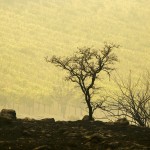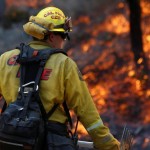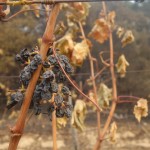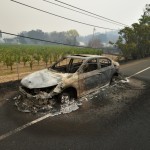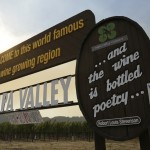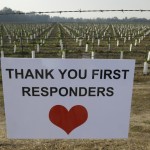Napa Rising After the Fire
By Nate Gartrell
When the North Bay burned for days on end last October, it felt like blue skies would never shine down on the area again. A black and brown haze engulfed the Bay Area, as millions of people around the world waited on edge, watching in horror for days as the blazes grew, the evacuation orders spread, and reports of the devastation trickled in. Forty-three people and hundreds of pets and farm animals lost their lives. Thousands of Californians were displaced, each experiencing a personal tragedy when they returned to their properties and found black and grey nothingness where their homes once stood. The historical fires have changed this state’s history; folks will be talking about them for the next 100 years and beyond.
A large portion of the Napa Valley was affected, but Santa Rosa bore the brunt of the destruction to homes and structures. Entire neighborhoods were destroyed, and much of the national media coverage in the aftermath has had an unintended effect; according to multiple Napa Valley business owners interviewed by Local Happenings, a lot of out-of-state tourists who don’t know the area have come away with the impression that most of wine country is no more.
“The worst of the devastation was in Santa Rosa,” Napa Chamber of Commerce CEO Travis Stanley said. “But if I’m in Virginia, and I see footage of neighborhoods burning in the Napa Valley, all I see is, ‘the Napa Valley is on fire.’”
As the recovery effort continues in Santa Rosa and throughout the Napa Valley, though, local business owners are facing a new challenge: attracting tourists and shoppers to the area, in the wake of the state’s deadliest fire spree. To prepare for the holiday season, local shop and winery owners have a simple message: if you’ve been planning a trip to the Napa Valley this year, there’s no need to cancel. They’re open for business and, in true Napa fashion, they’re helping organize charity events to benefit those impacted by the fires.
“The best way to help the Napa Valley is to encourage people to visit and experience the Napa Valley spirit in person and see for themselves that the Napa Valley is just as beautiful as ever,” said Angela Jackson, the media relations director at a local group called Visit Napa Valley, which helps plan events and encourage tourism in the region.
There are too many holiday events to describe here, so check out Local Happenings‘ calendar in this magazine or online, or go to www.VisitNapaValley.com. However, December will see a return of the popular Napa Valley Wine Trolley “Holiday Light Tours,” which start Dec. 1, 2, and 3, and continue for the next two weekends, from 6:30 to 8 p.m. The tours take guests through downtown Napa and its Victorian neighborhoods on a vintage cable car complete with carols from the 1890s-1940s. Proceeds from each tour will be donated to the Foster Children of Napa Valley.
Other popular December events include the “Brightest Town in Napa Valley” in Yountville, featuring six weeks of holiday-related events, activities and performances, including carriage rides through town, holiday movies, photos with Santa, wreath making classes, a Santa’s Workshop, gourmet food walking tours, holiday cooking and cocktail classes, theater performances, ugly sweater parties, SantaCon Yountville, and more.
Tourism is a pillar of the region’s income, and shows no sign of stopping; the region added more than 2,000 tourism jobs from 2014-16, with a combined 2016 payroll of $387 million according to a study released last year. It’s a $1.92 billion industry that generated $80.4 million in tax revenues. And a large chunk of that comes during the Thanksgiving/Christmas/holiday season, when good wine, food, and sweets are most important.
“[The fires] threaten to interrupt our flow of visitors to the area, in what is typically one of the busiest times of the year,” Stanley said.
All and all, 27 wineries were damaged, some significantly; the Ahh Winery at Glen Ellen was utterly destroyed. Unlike the South Napa quake of 2014, however, the fires left most of downtown Napa—and almost all of the area’s more than 1,200 wineries—unscathed.
“There won’t be as much rebuilding needed downtown like there was during the [2014] earthquake. There are a lot of people who were really adversely affected by the fires,” Stanley said. “But at least the businesses didn’t burn down.”
As often happens during tragedies, from the stories of the fires emerged tales of heroism and the community coming together. In Vallejo, the Solano Fairgrounds were transformed into an impromptu staging ground for farm animals affected by the fire, and volunteers poured in from the Bay Area to help. Police and fire departments throughout California sent men and women to help with the emergency response and coordinating evacuations. And in Napa’s Browns Valley, two contractors, Dan Wynn and his boss, Eli Ponce, jumped into action and used two bulldozers to build a fire break in the heat of the moment, saving an entire neighborhood in the process.
“Yes, he saved my house and this neighborhood would look like Fountain Grove if they hadn’t saved,” Browns Valley area resident Stephen Greco said, referencing one of the hardest-hit neighborhoods in Santa Rosa.
Wynn’s harrowing story (described in our sidebar) had a happy ending, but it’s difficult to imagine what he and Ponce went through. They took minimal breaks during a five-day period, surviving—as Wynn describes it—“purely on adrenaline” and knowing that they were the only thing standing in the way of the fire. They succeeded in creating a fire break in the valley—at times having to dump dirt on the fire to extinguish parts of it—and the community response has been incredible; Ponce and Wynn were immediately hailed as heroes.
“If you look at what happened in Santa Rosa, that could have easily happened in Browns Valley,” Wynn said. “Once homes start burning up, there isn’t much anyone can do.”
The community has responded to the tragedy by coming together, including with a series of wine and food events with proceeds being donated to the recovery effort.
“Many of the wineries in Napa Valley are donating their tasting room fees to fire relief funds, as well as hosting fundraisers for fire relief,” Jackson said.
“Cabernet Season, which begins in November and continues through April, is one of the best times to visit the Napa Valley,” she continued. “It’s a time when the pace slows down, the natural beauty of the vines shine, and when the chefs offer heartier meals, which pair perfectly with Napa Valley Cabernet Sauvignon.”
November saw two major fundraising events, including a week-long “ChefsGiving” event to help those directly impacted. On Dec. 2, the Culinary Institute of America hosted a benefit dinner and auction with every dollar of the proceeds going to the region’s recovery effort. In downtown Napa, Cadet’s Wine and Beer Bar helped organize a beer crawl fundraiser, and First Street Napa in partnership with Trademark Property Co. offered a matching donation of up to $50,000 for the Napa Valley Community Foundation Disaster Relief Fund.
“The outpouring of support from around the world has been heartwarming to everyone in our community, and the spirit of collaboration to rebuild and reopen is remarkable,” said Clay Gregory, president and CEO of Visit Napa Valley, in a statement. “Our thoughts remain with those impacted by these wildfires, including the more than 13,000 people whose jobs are supported by the Napa Valley tourism industry.”
For additional information on local events in the Napa Area, check out www.VisitNapaValley.com, or follow @VisitNapaValley on Facebook and Twitter.
- Melted metal flows from a burned out car abandoned on a highway during the Valley fire in Middletown, California on September 13, 2015. The governor of California declared a state of emergency Sunday as raging wildfires spread in the northern part of the drought-ridden US state, forcing thousands to flee the flames. The town of Middletown, population 1,300, was particularly devastated by the Valley Fire, according to local daily Santa Rosa Press-Democrat, which said the fire grew from 50 acres to 10,000 over just five hours Saturday — before quadrupling in size overnight. AFP PHOTO/JOSH EDELSON (Photo credit should read Josh Edelson/AFP/Getty Images)
- Smoke from the Nuns fire wafts over the Welcome to the Napa Valley sign, Monday, Oct. 16, 2017, in Oakville, Calif. State and local officials say they are trying to get people back into their homes, but they cautioned that it could take days and even weeks for neighborhoods hard hit by Northern California wildfires. (AP Photo/Eric Risberg)
- A sign thanking first responders hangs by a newly planted vineyard Monday, Oct. 16, 2017, in Napa, Calif. With the winds dying down, fire crews gained ground as they battled wildfires that have devastated California wine country and other parts of the state over the past week, and thousands of people got the all-clear to return home. (AP Photo/Eric Risberg)
Local Heroes Emerge as their Neighborhood is Threatened
By Nate Gartrell
Dan Wynn was in San Francisco enjoying Fleet Week with his daughter the Sunday the fires started, when he noticed a black cloud on the distant horizon. He had no idea what the next five days would entail for him and his boss, Eli Ponce.
That night, in Napa, as she watched the flames creep towards them, it was Wynn’s daughter who sounded the alarm.
“She came running in and said, ‘Dad, the mountain by our house is on fire,’” Wynn recalled. The time was around 11:35 p.m.
Wynn called Ponce, and the two of them did the only thing they could do: they pulled together a couple bulldozers and began trying their hardest to set up a big enough fire break that the flames wouldn’t be able to reach a nearby neighborhood and hundreds of homes. They told friends approximately where they could be found and headed into the night alone, towards hellfire and utter devastation.
As he worked to churn dirt between the houses and fire, occasionally driving straight through the blaze to do it, Wynn saw the ground get so hot the flames turned pink. It was a moment only comparable to one other time in Wynn’s life.
“It reminded me of the Persian Gulf War when all the oil fields were on fire,” said Wynn, a U.S. Marine Corps veteran of six years.
Ponce, Wynn said, “Did a great job.” The two worked alone together for 18 hours, but it didn’t take that long to realize that they were the last line of defense.
“There was no one else out there,” Wynn said.
Wynn works at E Ponce and Sons Contracting, and he said he’s got plenty of experience driving bulldozers, rock trucks, and all kind of other heavy machinery.
“My job is kind of like big Tonka toys for adults,” he joked. But using them to build fire breaks in the dead of night, with flames all around and smoke billowing in your face, is another story.
“It was an emergency situation,” he said. “We were lucky to have equipment that was right there ready to go.”
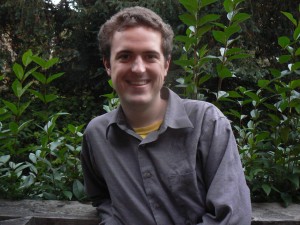 Nate Gartrell grew up in Benicia, studied journalism in college, and has written for a handful of media outlets since age 15. He aspires to visit all 30 Major League Baseball stadiums and to hit the trifecta at the horse track.
Nate Gartrell grew up in Benicia, studied journalism in college, and has written for a handful of media outlets since age 15. He aspires to visit all 30 Major League Baseball stadiums and to hit the trifecta at the horse track.

